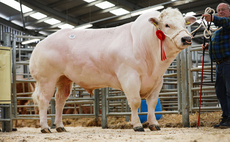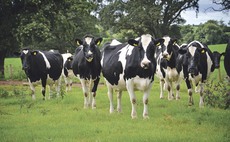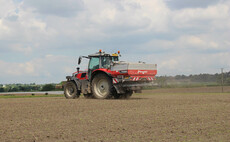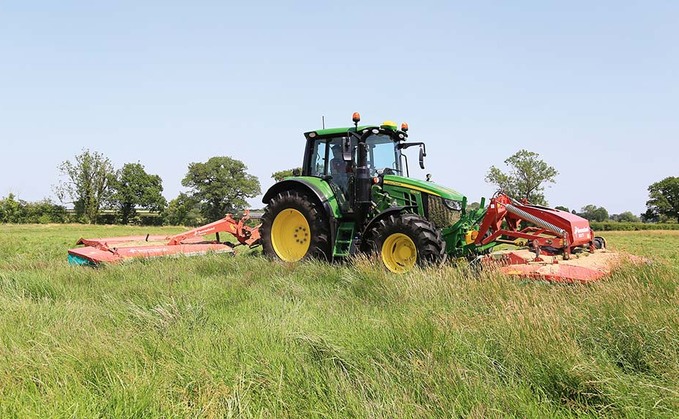
Featuring dramatic new styling, the 6120M from John Deere has a lot to offer on paper and should appeal to a wide range of farm types. To see how it stands up to various tasks on a mixed farm, Alex Heath put it to work.
Launched amid a raft of larger and more headline grabbing models, the new range of M Series tractors from John Deere has been redeveloped to include four brand new models at the bottom of the 10-strong roster of the manufacturer's basic range.
Ranging from 90-120hp (rated power), the external design of the short frame 6M Series takes a dramatic departure from the manufacturer's previous offerings, purposefully aimed at the likes of Massey Ferguson's 5700S Series, with an aggressively sloping bonnet designed for greater visibility.
And while the previous generation of 6Ms had a distinct place in the manufacturer's marketing structure, the latest models blur the lines between utilitarian dependability and luxury, as found in the firm's premium 6R range.
As we found out, the 6M can be specced to the hilt, with its own miniature Command Arm featuring intuitive and ergonomic controls, as well as plenty of functionality and additions such as the firm's Greenstar GPS automated steering. The Premium-spec that was sent had nearly every option box ticked, bringing it incredibly close in features to the upmarket R Series.
To test its mettle, we put it to work on a mixed farm, making haylage among other tasks. Completing all operations, it gave us a good flavour of its power, manoeuvrability, visibility and features. Also fitted to the tractor was the manufacturer's top spec 623R MSL front loader.
Engine

All models in the short frame range, as well as those in the small frame and one medium sized model, use the same 4.5-litre, four-cylinder engine.
Power-wise, the 6120M is an able performer. With grass to be cut, we attached a rear mower conditioner and, with some scepticism, attached a front mo-co to the four-tonne front linkage for good measure. However, the tractor managed admirably, dropping 5.4m-worth of grass consistently at 12kph on each pass.
With up to 145hp on tap at maximum power, coupled with the firm's Intelligent Power Management (IPM) boost function kicking in for pto and transport application, giving an extra 12hp, the little 6M is a powerhouse with a diminutive stature. Even with a front grill full of shed seeds, it performed well, with the engine speed or pto rarely dropping off. The tractor came with the optional three-speed pto pack, consisting 540, 540E and 1,000rpm at the rear.
Fuel usage during our time with the tractor was frugal. A total of 18 hours were worked, before we were forced into refuelling. This consisted of six hours of mowing, four hours of tedding and the same for raking, plus a good deal of road work towing trailers mixed in. Running on fumes, and with an excruciatingly loud buzzer going off for the last half hour of the drive back to the yard, 190 litres were added, while AdBlue usage was negligible.
The bonnet itself lifts to reveal the cooling pack and air filter at the front, while the side panels are held firmly in place by magnets. Access to the main filters and oil filler cap on the near side is good, although the manufacturer has also added a dipstick that can be easily accessed without removing any panels.
Controlling emissions produced by the Stage 5 engine is in a simpler arrangement than its bigger stablemates, consisting only of a diesel oxidising catalyst and selective catalytic reduction with AdBlue, which will appeal to those who do not want the hassle of particulate filter regenerations.
Transmission
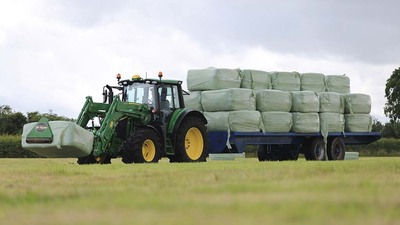
Until recently, the most advanced transmission in the 6M tractors was the Command Quad Plus gearbox, and that is what was fitted to the test unit. Simple and intuitive to use, operators can set the transmission to their preference, be it nudging the stick for manual changes or using it in automatic shifting mode.
Offering six ranges with four speeds in each, speed matching to the job in hand is simple enough, with 24 gears to select in either direction. Five buttons on the armrest select which range is to be used; A, B, C or D are ideal for fieldwork such as mowing, tedding, raking and cultivations.
When a single range is selected, gear changes are limited to that range, while the fifth button allows speed changes from the B range, right through to the highest F range to be implemented.
An automatic function removes the need for pushing or pulling on the stick to change gear, with the tractor doing that itself. The aggressiveness of the shifting can also be adjusted, allowing for faster or slower gear changes, while there is a rocker switch which enables two different start-off gears, handy when towing a trailer.
Cab
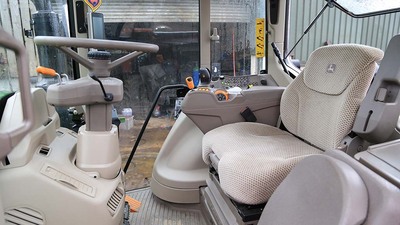
Operators are graced with the same cab frame as the previous generation of M Series tractors, and the 30 Series before that. However, it has been reworked with new plastics on the external corners and a new sleek roof line.
Inside the six-post cab, controls remain simple and fall to hand easily. On the right-hand fender, a multitude of buttons are clearly labelled and grouped, allowing for shortcuts into the menu, along with climate controls, four-wheel drive and diff-lock engagement and lighting. Also, there are spool controls, either manual levers or, in the case of the test tractor, electric paddles.
Hydraulic functions can also be controlled via the integrated joystick on the armrest, however, the functionality of this is limited to three predefined modes, including loader mode and two modes which control either the front or rear hydraulics. We found this was limiting, as the choice to select a front and rear spool was absent, meaning controlling the front and rear mower set-up had to be done with the paddles, unlike on R Series where the joystick has more functionality.
However, for loader work, the joystick comes into its own, with a reversing shuttle activated by your thumb allowing for easy direction changes, while gear shift can be done with two buttons on the top.
The steering wheel has rake and reach adjustment, but the dash panel in front has been ousted. Instead, all machine information is presented on a sleek screen mounted on the right-hand A-pillar.
The screen is split in two, with the top two-thirds showing the usual information, such as speed, engine rpm, gear selection, fluid levels and temperatures, while the bottom third is the control terminal.
d
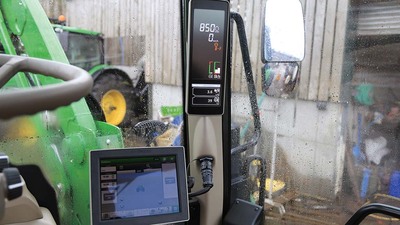
Although tiny, this screen displays relevant information with clarity. The operator can also select and customise five run screens, each displaying two pieces of information. This is selected by a simple scroll wheel on the fender, with the run screens rattled through with the same wheel. For instance, both front and rear pto speeds can be displayed, or linkage positions and fuel use per hour. The options are vast. Although not available at the time of the test, the mini screen can now also run basic auto steer functions. Instead, ours came fitted with the manufacturer's 4640 plug-in screen, offering the full suite of functions, including section control and IsoBus capabilities.
Linkage position for the rear is done with the same position setter the manufacturer has used for years, offering good enough control over height and depth of the implement.
While most premium ranges have moved to a four-post design, the 6M keeps the short door and window arrangement, which is no bad thing. Access is acceptable, while two side windows allow for some air movement if you do not want a fan blowing all day. The front window also has a more pronounced bow to it offering more space.
However, while visibility for the most part is good, with the tractor's edges easily identifiable, views to the loader headstock are poor. This is in part down to the loader's staunch boom design, but also the wide bonnet - athough this slopes, it does not allow you to see within two metres of its front. Also, views to the hitch are shocking. Even though it extends, it is blocked by the trailer's hydraulic braking block.
The cab is certainly a comfortable, quiet and easy place to work, well laid out and practical as would be expected for a tractor with a price tag of £135,422 as tested, not including the loader.
pic
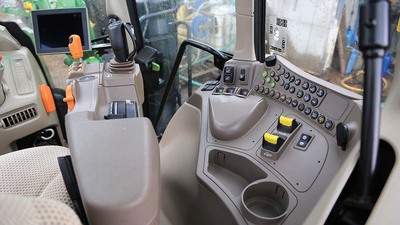
Hydraulics and loader
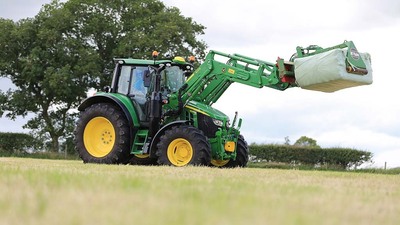
Hydraulic performance is rapid, with the optional 114 litres per minute pump. Up to four spools can be fitted at the rear and three in the middle. Opting for mid-mount spools also allows the front linkage to be operated, with an addition spool at the front. These are activated when the loader is removed, via a simple tap on the near side.
Fitted to the tractor was the manufacturer's 623R loader. This mechanical self-levelling loader will lift 2,302kg to a maximum height of 4.09 metres. Loader functions are swift and precise; the joystick being a real boon. Cycle times are good, although there is little cushioning when dropping the loader down from anything more than a metre or so.
As alluded to, if swapping between multiple attachments each day, visibility to the headstock is severely hampered, meaning a make-do attitude to which attachment is used could become prevalent. This said, visibility to raised attachments is good, with a small window in the roof providing, for the most part, unimpeded views.
The R Series loader comes in at an extra £12,133 as tested, although the manufacturer has recently released a more basic M Series version, with narrower booms and a lower lift capacity, which could be a better match, with a lower price tag.
As is to be expected from a tractor with a 2.4m wheelbase, turning circle is impeccable, but not at the expense of stability, with the tractor reluctant to lift its rear wheels even with two Quadrant haylage bales on the front end.
Verdict
The 6120M will inevitably be a good seller for the manufacturer, offering farmers a complementary mix of power, nimbleness and, on the whole, good visibility. This puts it firmly in the sight of livestock farmers for loader and grassland work, as well as arable farmers with a lighter footprint and its ability to add precision farming programmes on to it.
If you are in the market for a 120hp tractor, this one is certainly a strong contender and offers a huge amount of spec choice in a small package. However, the line between Deere's low-spec M and high-spec R models is now getting decidedly blurry, especially when you consider that a fully loaded 6M and mid-spec 6R will nearly be the same money. The only apparent advantages the premium range has is a 10kph higher road speed, air brakes and slightly more customisability.





















